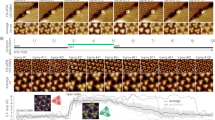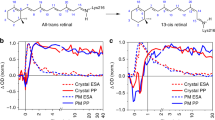Abstract
Dynamic changes in protein conformation in response to external stimuli are important in biological processes, but it has proved difficult to directly visualize such structural changes under physiological conditions1,2,3,4,5,6,7,8,9,10. Here, we show that high-speed atomic force microscopy7 can be used to visualize dynamic changes in stimulated proteins. High-resolution movies of a light-driven proton pump, bacteriorhodopsin11,12, reveal that, upon illumination, a cytoplasmic portion of each bacteriorhodopsin monomer is brought into contact with adjacent trimers. The bacteriorhodopsin–bacteriorhodopsin interaction in the transiently formed assembly engenders both positive and negative cooperative effects in the decay kinetics as the initial bacteriorhodopsin recovers and, as a consequence, the turnover rate of the photocycle is maintained constant, on average, irrespective of the light intensity. These results confirm that high-resolution visualization is a powerful approach for studying elaborate biomolecular processes under realistic conditions.
This is a preview of subscription content, access via your institution
Access options
Subscribe to this journal
Receive 12 print issues and online access
$259.00 per year
only $21.58 per issue
Buy this article
- Purchase on Springer Link
- Instant access to full article PDF
Prices may be subject to local taxes which are calculated during checkout




Similar content being viewed by others
References
Binnig, G., Quate, C. F. & Gerber, C. Atomic force microscope. Phys. Rev. Lett. 56, 930–933 (1986).
Drake, B. et al. Imaging crystals, polymers and processes in water with the atomic force microscope. Science 243, 1586–1589 (1989).
Butt, H. J., Downing, K. H. & Hansma, P. K. Imaging the membrane protein bacteriorhodopsin with the atomic force microscope. Biophys. J. 58, 1473–1480 (1990).
Müller, D. J. et al. Atomic force microscopy of native purple membrane. Biochim. Biophys. Acta 1460, 27–38 (2000).
Müller, D. J. AFM: a nanotool in membrane biology. Biochemistry 47, 7986–7998 (2008).
Ando, T. et al. A high-speed atomic force microscope for studying biological macromolecules. Proc. Natl Acad. Sci. USA 98, 12468–12472 (2001).
Ando, T., Uchihashi, T. & Fukuma, T. High-speed atomic force microscopy for nano-visualization of dynamic biomolecular processes. Prog. Sur. Sci. 83, 337–437 (2008).
Hansma, P. K., Schitter, G., Fantner, G. E. & Prater, C. Applied physics. High-speed atomic force microscopy. Science 314, 601–602 (2006).
Fantner, G. E. et al. Components for high speed atomic force microscopy. Ultramicroscopy 106, 881–887 (2006).
Yamashita, H. et al. Tip–sample distance control using photothermal actuation of a small cantilever for high-speed atomic force microscopy. Rev. Sci. Instrum. 78, 083702 (2007).
Haupts, U., Tittor, J. & Oesterhelt, D. Closing in on bacteriorhodopsin: progress in understanding the molecule. Annu. Rev. Biophys. Biomol. Struct. 28, 367–399 (1999).
Lanyi, J. K. Bacteriorhodopsin. Annu. Rev. Physiol. 66, 665–688 (2004).
Kimura, Y. et al. Surface of bacteriorhodopsin revealed by high-resolution electron crystallography. Nature 389, 206–211 (1997).
Luecke, H., Schobert, B., Richter, H. T., Cartailler, J. P. & Lanyi, J. K. Structure of bacteriorhodopsin at 1.55 Å resolution. J. Mol. Biol. 291, 899–911 (1999).
Dencher, N. A., Dresselhaus, D., Zaccai, G. & Buldt, G. Structural changes in bacteriorhodopsin during proton translocation revealed by neutron diffraction. Proc. Natl Acad. Sci. USA 86, 7876–7879 (1989).
Subramaniam, S., Gerstein, M., Oesterhelt, D. & Henderson, R. Electron diffraction analysis of structural changes in the photocycle of bacteriorhodopsin. EMBO J. 12, 1–8 (1993).
Kamikubo, H. et al. Structure of the N intermediate of bacteriorhodopsin revealed by X-ray diffraction. Proc. Natl Acad. Sci. USA 93, 1386–1390 (1996).
Thorgeirsson, T. E. et al. Transient channel-opening in bacteriorhodopsin: an EPR study. J. Mol. Biol. 273, 951–957 (1997).
Brown, L. S., Needleman, R. & Lanyi, J. K. Conformational change of the E–F interhelical loop in the M photointermediate of bacteriorhodopsin. J. Mol. Biol. 317, 471–478 (2002).
Shibata, M. & Kandori, H. FTIR studies of internal water molecules in the Schiff base region of bacteriorhodopsin. Biochemistry 44, 7406–7413 (2005).
Sass, H. J. et al. Structural alterations for proton translocation in the M state of wild-type bacteriorhodopsin. Nature 406, 649–653 (2000).
Luecke, H., Schobert, B., Richter, H. T., Cartailler, J. P. & Lanyi, J. K. Structural changes in bacteriorhodopsin during ion transport at 2 angstrom resolution. Science 286, 255–261 (1999).
Subramaniam, S. & Henderson, R. Molecular mechanism of vectorial proton translocation by bacteriorhodopsin. Nature 406, 653–657 (2000).
Vonck, J. Structure of the bacteriorhodopsin mutant F219 L N intermediate revealed by electron crystallography. EMBO J. 19, 2152–2160 (2000).
Xiao, W., Brown, L. S., Needleman, R., Lanyi, J. K. & Shin, Y. K. Light-induced rotation of a transmembrane alpha-helix in bacteriorhodopsin. J. Mol. Biol. 304, 715–721 (2000).
Otto, H. et al. Aspartic acid-96 is the internal proton donor in the reprotonation of the Schiff base of bacteriorhodopsin. Proc. Natl Acad. Sci. USA 86, 9228–9232 (1989).
Heymann, J. B. et al. Charting the surfaces of the purple membrane. J. Struct. Biol. 128, 243–249 (1999).
Korenstein, R., Hess, B. & Markus, M. Cooperativity in the photocycle of purple membrane of Halobacterium halobium with a mechanism of free energy transduction. FEBS Lett. 102, 155–161 (1979).
Váró, G., Needleman, R. & Lanyi, J. K. Protein structural change at the cytoplasmic surface as the cause of cooperativity in the bacteriorhodopsin photocycle. Biophys. J. 70, 461–467 (1996).
Oesterhelt, D. & Stoeckenius, W. Isolation of the cell membrane of Halobacterium halobium and its fractionation into red and purple membrane. Methods Enzymol. 31, 667–678 (1973).
Acknowledgements
This work was supported by Japan Science and Technology Agency for Core Research for Evolutional Science and Technology (T.A.), Grants-in-Aids for Scientific Research from Japan Society for the Promotion of Science (JSPS) (no. 15101005; T.A.) and from the Ministry of Education, Culture, Sports, Science and Technology, Japan (no. 19042009, T.U.; no. 20108014, H.K.), and Research Fellowships of JSPS for Young Scientists (M.S. and H.Y.). The authors thank J.K. Lanyi, S.P. Balashov and L.S. Brown for comments on the draft.
Author information
Authors and Affiliations
Contributions
T.A., H.K. and M.S. conceived and designed the experiments. T.A. and T.U. developed the high-speed AFM instrument. T.U., M.S. and H.Y. performed the experiments. T.U. and M.S. analysed the data. T.A., T.U. and M.S. co-wrote the paper. All authors discussed the results and commented on the manuscript.
Corresponding author
Ethics declarations
Competing interests
The authors declare no competing financial interests.
Supplementary information
Supplementary information
Supplementary information (PDF 1530 kb)
Supplementary information
Supplementary information (MOV 4214 kb)
Supplementary information
Supplementary information (MOV 4381 kb)
Supplementary information
Supplementary information (MOV 4334 kb)
Supplementary information
Supplementary information (MOV 8851 kb)
Supplementary information
Supplementary information (MOV 3525 kb)
Rights and permissions
About this article
Cite this article
Shibata, M., Yamashita, H., Uchihashi, T. et al. High-speed atomic force microscopy shows dynamic molecular processes in photoactivated bacteriorhodopsin. Nature Nanotech 5, 208–212 (2010). https://doi.org/10.1038/nnano.2010.7
Received:
Accepted:
Published:
Issue Date:
DOI: https://doi.org/10.1038/nnano.2010.7
This article is cited by
-
Advantages and potential limitations of applying AFM kymograph analysis to pharmaceutically relevant membrane proteins in lipid bilayers
Scientific Reports (2023)
-
Voltage sensors of a Na+ channel dissociate from the pore domain and form inter-channel dimers in the resting state
Nature Communications (2023)
-
Technical advances in high-speed atomic force microscopy
Biophysical Reviews (2023)
-
Seeing the unseen: High-resolution AFM imaging captures antibiotic action in bacterial membranes
Nature Communications (2022)
-
Scanning probe microscopy
Nature Reviews Methods Primers (2021)



